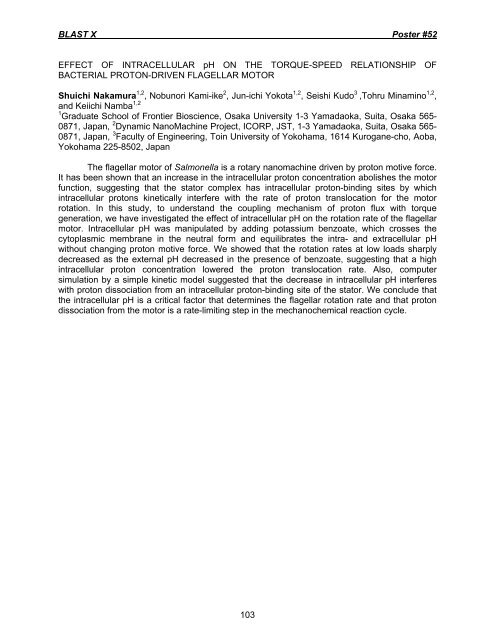POSTERS - BLAST X - University of Utah
POSTERS - BLAST X - University of Utah
POSTERS - BLAST X - University of Utah
Create successful ePaper yourself
Turn your PDF publications into a flip-book with our unique Google optimized e-Paper software.
<strong>BLAST</strong> X Poster #52<br />
EFFECT OF INTRACELLULAR pH ON THE TORQUE-SPEED RELATIONSHIP OF<br />
BACTERIAL PROTON-DRIVEN FLAGELLAR MOTOR<br />
Shuichi Nakamura 1,2 , Nobunori Kami-ike 2 , Jun-ichi Yokota 1,2 , Seishi Kudo 3 ,Tohru Minamino 1,2 ,<br />
and Keiichi Namba 1,2<br />
1 Graduate School <strong>of</strong> Frontier Bioscience, Osaka <strong>University</strong> 1-3 Yamadaoka, Suita, Osaka 565-<br />
0871, Japan, 2 Dynamic NanoMachine Project, ICORP, JST, 1-3 Yamadaoka, Suita, Osaka 565-<br />
0871, Japan, 3 Faculty <strong>of</strong> Engineering, Toin <strong>University</strong> <strong>of</strong> Yokohama, 1614 Kurogane-cho, Aoba,<br />
Yokohama 225-8502, Japan<br />
The flagellar motor <strong>of</strong> Salmonella is a rotary nanomachine driven by proton motive force.<br />
It has been shown that an increase in the intracellular proton concentration abolishes the motor<br />
function, suggesting that the stator complex has intracellular proton-binding sites by which<br />
intracellular protons kinetically interfere with the rate <strong>of</strong> proton translocation for the motor<br />
rotation. In this study, to understand the coupling mechanism <strong>of</strong> proton flux with torque<br />
generation, we have investigated the effect <strong>of</strong> intracellular pH on the rotation rate <strong>of</strong> the flagellar<br />
motor. Intracellular pH was manipulated by adding potassium benzoate, which crosses the<br />
cytoplasmic membrane in the neutral form and equilibrates the intra- and extracellular pH<br />
without changing proton motive force. We showed that the rotation rates at low loads sharply<br />
decreased as the external pH decreased in the presence <strong>of</strong> benzoate, suggesting that a high<br />
intracellular proton concentration lowered the proton translocation rate. Also, computer<br />
simulation by a simple kinetic model suggested that the decrease in intracellular pH interferes<br />
with proton dissociation from an intracellular proton-binding site <strong>of</strong> the stator. We conclude that<br />
the intracellular pH is a critical factor that determines the flagellar rotation rate and that proton<br />
dissociation from the motor is a rate-limiting step in the mechanochemical reaction cycle.<br />
103


